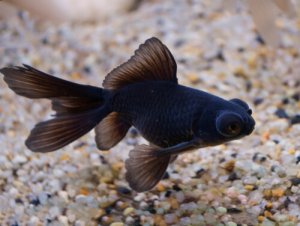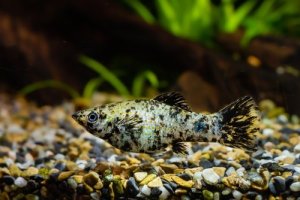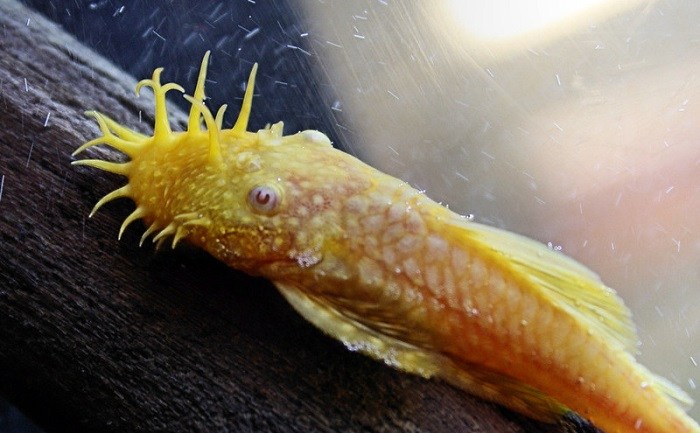
You may have seen the unusual-looking Bristlenose Pleco and decided that even though you like this popular fish, you want something that is still a little different. Enter the Albino Bristlenose Pleco. Yes, albinism exists in fish!
Some people find these fish a bit too alien looking for their tastes. However, if you are an adventurous aquarist, and you want a very striking-looking algae eater for your tank, this variant of the regular Bristlenose Pleco is definitely one to consider. Read on to find out all about their care, plus the important differences you will need to know.
Breed Overview
| Origin | Amazon River Basin |
| Lifespan | Up to 10 years |
| Size | 5” or up to 12cm when fully grown |
| Colors | A dark mottled brown |
| Food | Algae and other detritus |
| Tank Size | Minimum 30 gallons or 114 liters |
| Temperament | Peaceful, curious, easygoing |
| Water Temperature | 72-80 F or 22-28 C |
| Water pH | 5.5-6.5 |
Appearance
Just like you would imagine, the Albino Bristlenose Pleco Fish is a light-colored version of the typical dark, mottled Bristlenose Pleco. However, remember that albinism is a specific genetic mutation. It is not just light coloring. The Albino Bristlenose Pleco is a light cream color all over, with no spots of dark pigment at all.
What Causes Albinism In Pleco Fish?
So, what causes albinism in fish? The cause of albinism in all creatures is due to the lack of a specific enzyme that aids in the creation of dark-colored pigments. Later on in this article, you will see how albinism differs from leucism, but for now, it just helps to know that Albino Pleco‘s unique looks are caused by a genuine difference at the genetic level.
How Does The Albino Bristlenose Pleco Differ From Regular Bristlenose Pleco Fish?
If you already know a bit about albinism in mammals, you may have heard that it can affect hearing and eyesight. However, fortunately, studies on fish have shown there are not any significant differences in behavior between albino animals and their regular counterparts.
Thus, if you are worried that an Albino Pleco may be challenging to look after, you may find this is not the case – especially if you already have experience with Plecos.
Do Albino Fish Have Any Specific Needs?
In general, albino animals have some more sensitive characteristics and may often have poor eyesight and difficulty hearing. However, fortunately, albino fish, the Plecoincluded, do not share these characteristics. In fact, studies have shown they participate in all the same foraging behavior as their non-albino counterparts.
Tank Setup And Maintenance
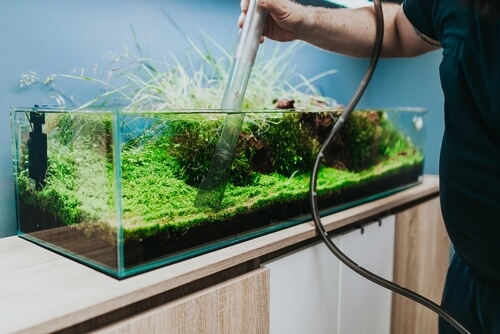
The Albino Bristlenose Plecohas roughly the same needs as the regular Bristlenose Pleco in terms of tank setup. For starters, you need a tank of at least 30 gallons or 114 liters so that these fish have enough space to grow and explore.
Secondly, it’s important the habitat is correct. They come from soft acidic water in the Amazon basin that is usually filled with driftwood, tree roots, and other organic matter. In fact, Plecos have been rumored to climb tree roots that protrude out of the water in their native habitat. Thus, adding lots of driftwood can help your fish feel at home.
Apart from this, create plenty of hidey-hole with strategically placed rocks and stones as well as plants that your Pleco can hide amongst and that will also help other tankmates feel safe.
Author’s Note: Never use sharp gravel in a tank that has a Pleco in it. This can hurt your fish’s delicate stomach, and make them much more prone to infection. Always use smooth large pebbles or sand instead.
Another thing you will have to consider for your tank is filtration. Fortunately, unlike some other Pleco species from faster-flowing waters, these fish do not need particularly strong filtration. A simple HOB filter that filters 4x the tank capacity per hour will do.
Tankmates
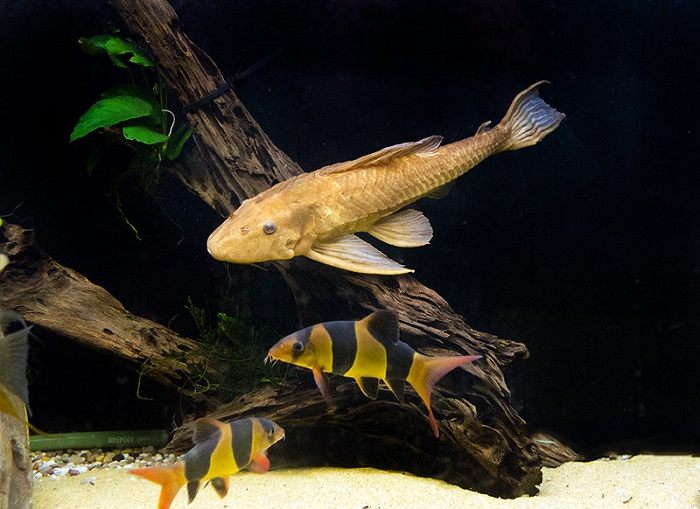
Like the similar Bristlenose Pleco, the Albino Bristlenose Plecocan makes great algae-eating tankmates for a variety of Amazonian and other species. These include:
Best Lighting For The Albino Bristlenose Pleco
You may have heard that some albino animals have poor eyesight and that bright light can be damaging to them. Fortunately, this does not apply to fish. You can use the same regular LED lighting with an Albino Pleco that you can with any other Bristlenose Pleco
Otherwise, your Pleco is mostly active at night, and they often enjoy shadowy places anyway to hide in, such as a length of PVC piping, something many aquarists add to their Pleco tanks.
Feeding
Fortunately, there is no difference between feeding an Albino Pleco and a regular Pleco. Simply feed algae wafers two to three times per week. Your Pleco will gobble them up and in the meantime will keep the stones, rocks, and sides of the tank free from algae with their unique feeding habits.
Author’s Note: Remember that no algae-eating fish can survive off tank algae alone. It’s always important to provide algae wafers so that they know they have a consistent source of nutrition. Apart from that, you can enrich their diet with sliced vegetables occasionally (no more than once per week) such as cucumber or zucchini.
Behavior And Temperament
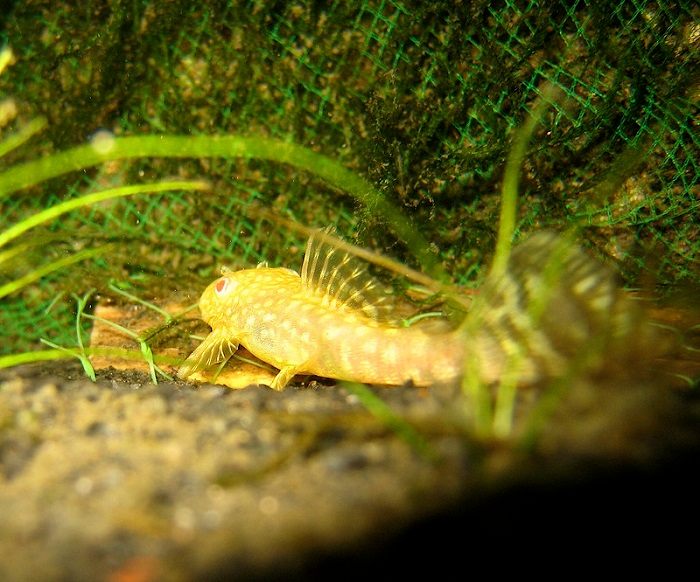
You will often catch your Plecohanging onto the side of the tank, eating algae off the glass. Apart from this, they keep to the bottom of the tank most of the time, where they hover up detritus. They are generally quite shy fish and in fact, they like to hide in rocky crevices or other hidden places.
Albino Bristlenose Pleco Differences In Behavior
These fish do not have any significant behavioral differences from their dark-colored counterparts. However, the main difference is that your aquarium can actually give them a chance to thrive. In the wild, albino fish are generally eaten by predators because of how much they stand out.
Algae Eating Behavior
Plecos in general eat algae not just off the sides of the tank but also off any rocks, driftwood, and decorations that you may have. This is one of the most appealing things about them and it can be a delight to watch them at work.
You may occasionally see your Pleco Fish swim up to the surface of the tank and gulp at the air. If this happens, you may wonder if they are hungry. However, this is actually a form of breathing. Plecos will sometimes breathe air if the water surrounding them is not oxygenated enough. So, take it as a sign that you need to clean your tank.
Pests And Diseases
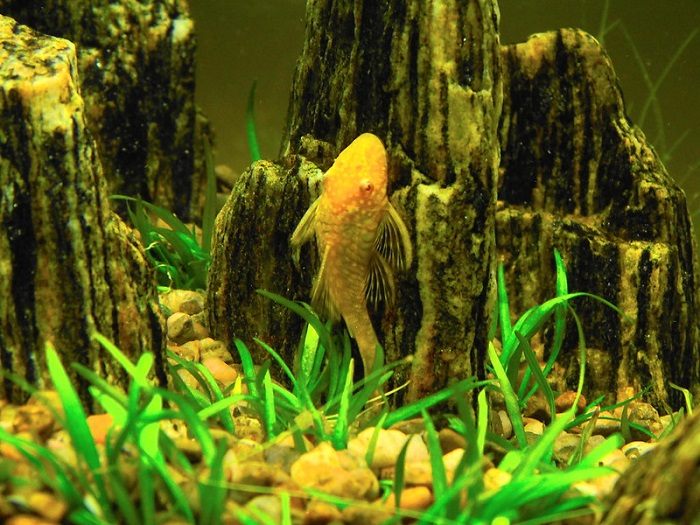
Pleco fish are generally hardy and don’t suffer from that many common fish ailments. However, there are some specific things you may consider regards an albino fish, so read on for more info.
Considerations For Albino Plecos
Albino Bristlenose Pleco fish are not necessarily less hardy than regular Pleco Fish. However, one consideration is that due to their pale coloring, it may be easier to spot some diseases and harder to spot others.
Ich:
Ich is a pale parasitic infection that shows up as white spots on your fish’s body. Pleco fish in general tend to be harder. However, if this disease does appear, it can be harder to spot than on darker-colored fish.
Fungal Infections:
some diseases caused by fungus such as velvet or gold dust disease may be hard to see due to the pale yellow coloring of an albino Bristlenose Pleco. Thus, it’s important to check carefully, however, dark-colored fungal infections will be easier to spot than on regular-colored fish.
Pleco Fungus:
This fungal infection is generally a pale color and thus it blends in against your pleco’s coloration. Therefore if you see any unusual textures on your pleco, especially around the mouth, be sure to take a closer look.
What Is The Difference Between Albinism And Leucism?
Neither albinism nor leucism is in fact a disease, and you Bristlenose Pleco can indeed live a rich and varied life that is as healthy as any other Pleco Fish regardless of their coloration. However, there is a difference between albinism and a similar genetic mutation called leucism.
In albinism, your fish is unable to produce the enzyme tyrosinase, which aids in the production of the dark pigment melanin. In leucism, it is that the pigment-producing cells themselves are not present in some or all of an animal’s body.
You can tell the difference between a true albino animal and one with leucism as an albino fish will have red or pink eyes with no pigment in the retina, whereas animals with leucism generally tend to have blue eyes.
Author’s Note: the difference in eye color is due to the amount of pigment in the eyes. In an albino animal, the total lack of pigment means that you can see the blood cells on the retina, giving the eyes a red color. Animals with leucism still have some pigment in their eyes, which may be a regular color apart from blue. Generally, most pale Bristlenose Plecos will be true albinos.
Breeding
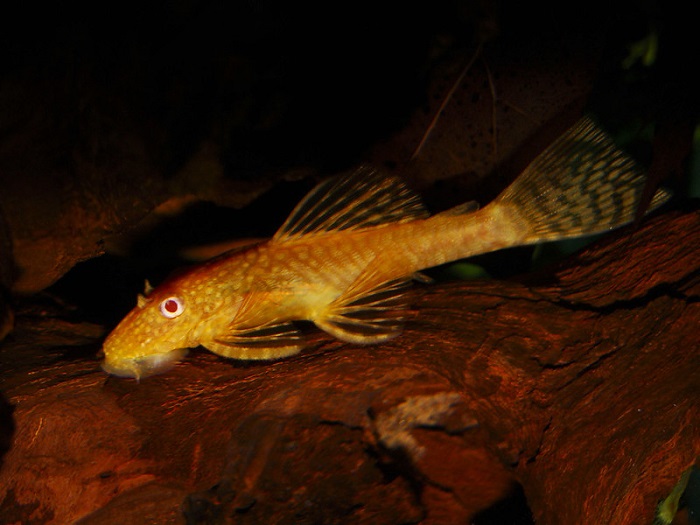
Due to its unique color, you may wish to breed your fish. However, this isn’t always as easy as it sounds. Read on for more details about breeding Pleco Fish – and the Albino Pleco specifically.
How To Breed Pleco Fish
Plecos are easy to look after, but they can be relatively difficult to breed. This means that it is better to already have experience with the species first before you attempt to breed them. Plecos are relatively shy, but their mating habits can be a delight to watch, even though they are sensitive to tank conditions and may not necessarily be willing to mate unless things are just right.
Once in a separate breeding tank, the male will generally trap the female in a cave or hidey-hole where she will lay her eggs and he will then fertilize them.
Then, the male will guard the eggs until they hatch, at which point it’s a good idea to remove him as he may eat the fry. Fry are still attached to the yolk sacs of the eggs and don’t have to be fed for the first few days. After that, you can feed them on crushed algae wafers.
How To Breed An Albino Pleco Fish
The best way of breeding an Albino Pleco fish is to cross two albino parents. This gives you a surefire chance of creating albino offspring. However, if you cross an Albino Pleco with a regular Pleco, the chances are, the offspring will not have the albino appearance. Alternatively, only about a quarter of them will.
This is because generally, the gene that causes albinism is recessive. This means that the offspring has to inherit two cop[ies, one from each parent, in order for it to manifest. Otherwise, they will carry the gene, but it may not result in a color change.
How Does Albinism Affect Your Pleco’s Genetics?
Your fish only has one copy of each gene inherited from each parent, and this will either be albino, or not albino.
For your fish to actually be albino, there must be an albino gene from each parent as the gene is recessive. This means that you need two copies for it to display. Otherwise, the dominant gene coding for dark pigment will prevail, and you will have a regular pleco
Will Albino Pleco Fish Have Albino Offspring?
As stated above, Albino Pleco fish will only have albino fry for certain if both parents are albino. Otherwise, an albino parent and a dark-colored parent may give birth to some albino fry if the right combination of genes is inherited. In other instances, two regular Plecos may create some albino offspring if both of them are carrying the albino gene without manifesting it.
Final Thoughts
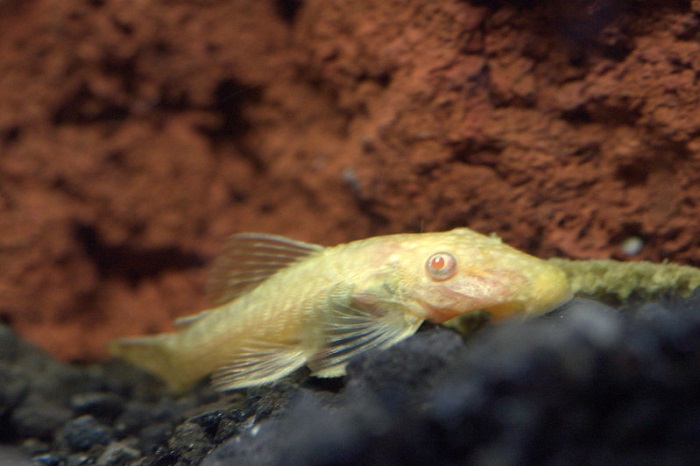
Ultimately, the Albino Bristlenose Pleco can be a great choice if you are looking for an unusual variant of this popular Pleco Fish that has more or less the same requirements and is equally easy to take care of.
It may seem like an albino fish needs special care, but truthfully, these guys have all the same behaviors and needs as their non-albino counterparts with the added bonus that they are a very distinctive and striking addition to your tank.



